stop start CHRYSLER PT CRUISER 2008 1.G User Guide
[x] Cancel search | Manufacturer: CHRYSLER, Model Year: 2008, Model line: PT CRUISER, Model: CHRYSLER PT CRUISER 2008 1.GPages: 491, PDF Size: 7.08 MB
Page 246 of 491
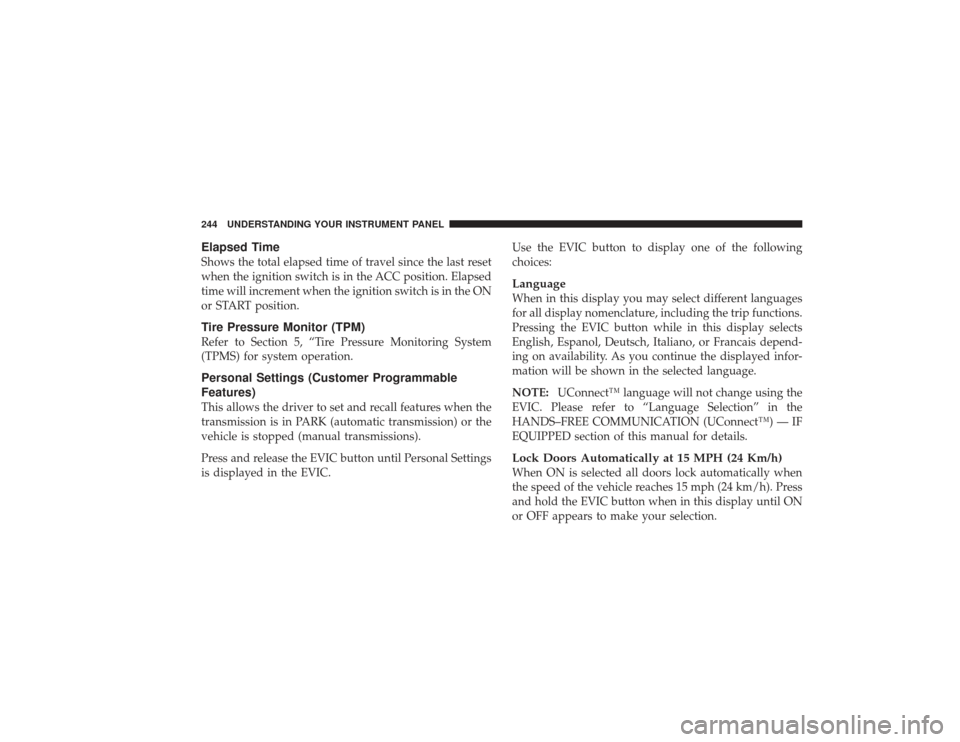
Elapsed TimeShows the total elapsed time of travel since the last reset
when the ignition switch is in the ACC position. Elapsed
time will increment when the ignition switch is in the ON
or START position.Tire Pressure Monitor (TPM)Refer to Section 5, “Tire Pressure Monitoring System
(TPMS) for system operation.Personal Settings (Customer Programmable
Features)This allows the driver to set and recall features when the
transmission is in PARK (automatic transmission) or the
vehicle is stopped (manual transmissions).
Press and release the EVIC button until Personal Settings
is displayed in the EVIC.Use the EVIC button to display one of the following
choices:
LanguageWhen in this display you may select different languages
for all display nomenclature, including the trip functions.
Pressing the EVIC button while in this display selects
English, Espanol, Deutsch, Italiano, or Francais depend-
ing on availability. As you continue the displayed infor-
mation will be shown in the selected language.
NOTE:
UConnect™ language will not change using the
EVIC. Please refer to “Language Selection” in the
HANDS–FREE COMMUNICATION (UConnect™) — IF
EQUIPPED section of this manual for details.Lock Doors Automatically at 15 MPH (24 Km/h)When ON is selected all doors lock automatically when
the speed of the vehicle reaches 15 mph (24 km/h). Press
and hold the EVIC button when in this display until ON
or OFF appears to make your selection.
244 UNDERSTANDING YOUR INSTRUMENT PANEL
Page 296 of 491
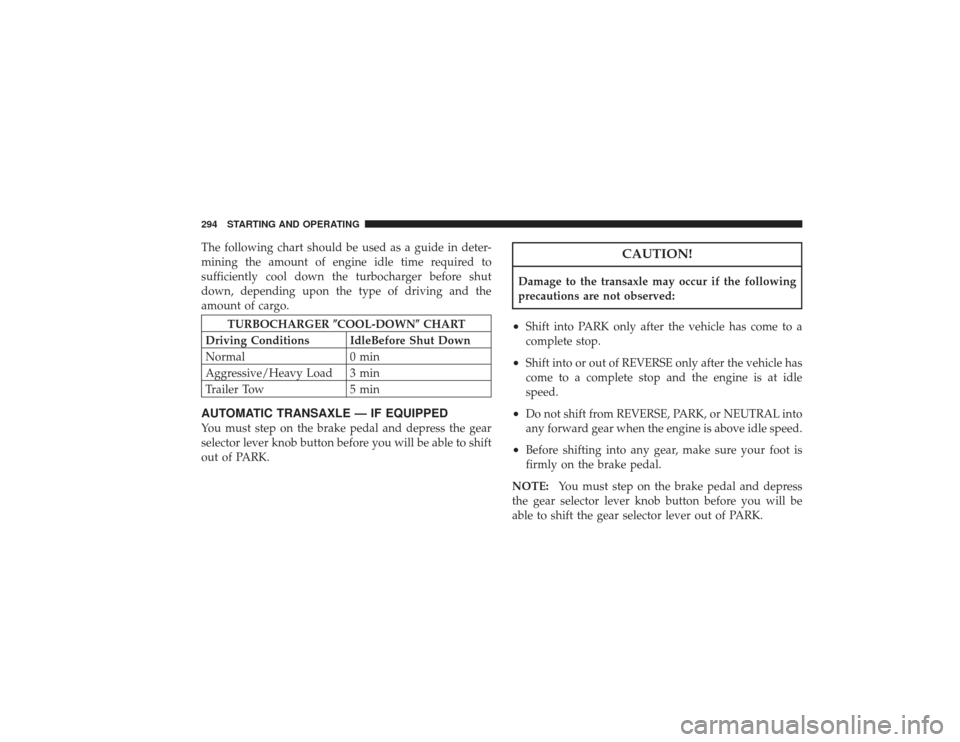
The following chart should be used as a guide in deter-
mining the amount of engine idle time required to
sufficiently cool down the turbocharger before shut
down, depending upon the type of driving and the
amount of cargo.
TURBOCHARGER COOL-DOWN CHART
Driving Conditions IdleBefore Shut Down
Normal 0 min
Aggressive/Heavy Load 3 min
Trailer Tow 5 min
AUTOMATIC TRANSAXLE — IF EQUIPPEDYou must step on the brake pedal and depress the gear
selector lever knob button before you will be able to shift
out of PARK.
CAUTION!
Damage to the transaxle may occur if the following
precautions are not observed:•
Shift into PARK only after the vehicle has come to a
complete stop.
•
Shift into or out of REVERSE only after the vehicle has
come to a complete stop and the engine is at idle
speed.
•
Do not shift from REVERSE, PARK, or NEUTRAL into
any forward gear when the engine is above idle speed.
•
Before shifting into any gear, make sure your foot is
firmly on the brake pedal.
NOTE: You must step on the brake pedal and depress
the gear selector lever knob button before you will be
able to shift the gear selector lever out of PARK.
294 STARTING AND OPERATING
Page 298 of 491

feature is inoperable. The engine can be started and
stopped but the key cannot be removed until you obtain
service.FOUR-SPEED AUTOMATIC TRANSAXLEThe electronically controlled transaxle provides a precise
shift schedule. The transaxle electronics are self calibrat-
ing; therefore, the first few shifts on a new vehicle may be
somewhat abrupt. This is a normal condition, and preci-
sion shifts will develop within a few shift cycles.RESET MODEThe transaxle is monitored electronically for abnormal
conditions. If a condition is detected that could cause
damage, the transaxle shifts automatically into second
gear. The transaxle remains in second gear despite the
forward gear selected. PARK, REVERSE, and NEUTRAL
will continue to operate. This second gear limp-in feature
allows the vehicle to be driven to a dealer for service
without damaging the transaxle.In the event that the problem has been momentary, the
transaxle can be reset to regain all forward gears.
Stop the vehicle and shift the gear selector lever into
PARK.
Turn the Key to OFF then restart the engine.
Shift the gear selector lever into DRIVE and resume
driving.
If the transaxle cannot be reset, authorized dealer service
is required.
NOTE:
Even if the transaxle can be reset, it is recom-
mended that you visit an authorized dealer at your
earliest possible convenience. Your authorized dealer has
diagnostic equipment to determine if the problem could
recur.296 STARTING AND OPERATING
Page 300 of 491

The following indicators should be used to ensure that
you have engaged the transmission gear selector lever
into the PARK position:•
When shifting the gear selector lever into PARK,
depress the button on the gear selector lever knob and
firmly move the lever all the way forward until it
stops.
•
Look at the shift indicator window on the console to
ensure it is in the PARK position.
•
When engaged in PARK, you will not be able to move
the gear selector lever rearward without depressing
the gear selector lever knob button
CAUTION!
Before shifting the gear selector lever out of PARK,
you must turn the ignition from LOCK to ON so the
steering wheel and gear selector lever are released.
Otherwise, damage to the steering column or gear
selector lever could result.REVERSEShift into this range only after the vehicle has come to a
complete stop.NEUTRALThe engine may be started in this range.DRIVE / OVERDRIVEThis range should be used for most city and highway
driving. It provides smoothest upshifts and downshifts,
and best fuel economy.
298 STARTING AND OPERATING
Page 302 of 491

AUTOSTICK OperationThe AUTOSTICK position is just below the OVERDRIVE
position and is identified by the word “AUTOSTICK”.
When you place the gear selector lever in the
AUTOSTICK position, it can be moved from side to side.
Moving the lever to the left (-) triggers a downshift and to
the right (+) an upshift. The gear position will be shown
in the transmission gear display, located in the instru-
ment cluster.
You can shift in or out of the AUTOSTICK mode at any
time without taking your foot off the accelerator pedal. If
you choose the OVERDRIVE mode, the transmission will
operate automatically; shifting between the four avail-
able gears. When you wish to engage AUTOSTICK,
simply move the gear selector lever to the AUTOSTICK
position. The transmission will remain in the current gear
until an upshift or downshift is chosen.Move the lever back to the OVERDRIVE position to shift
out of the AUTOSTICK mode.
AUTOSTICK General Information
•
The transmission will automatically upshift from first
to second gear and from second to third gear when
engine speed reaches about 6,300 RPM.
•
Downshifts from third to second gear above 74 mph
(119 km/h) and from second to first gear above 41
mph (66 km/h) will be ignored.
•
You can start out in first, second, or third gear. Shifting
into fourth gear can occur only after vehicle speed
reaches 15 mph (24 km/h).
•
The transmission will automatically downshift to first
gear when coming to a stop.
•
Starting out in third gear is helpful in snowy or icy
conditions.
300 STARTING AND OPERATING
Page 304 of 491
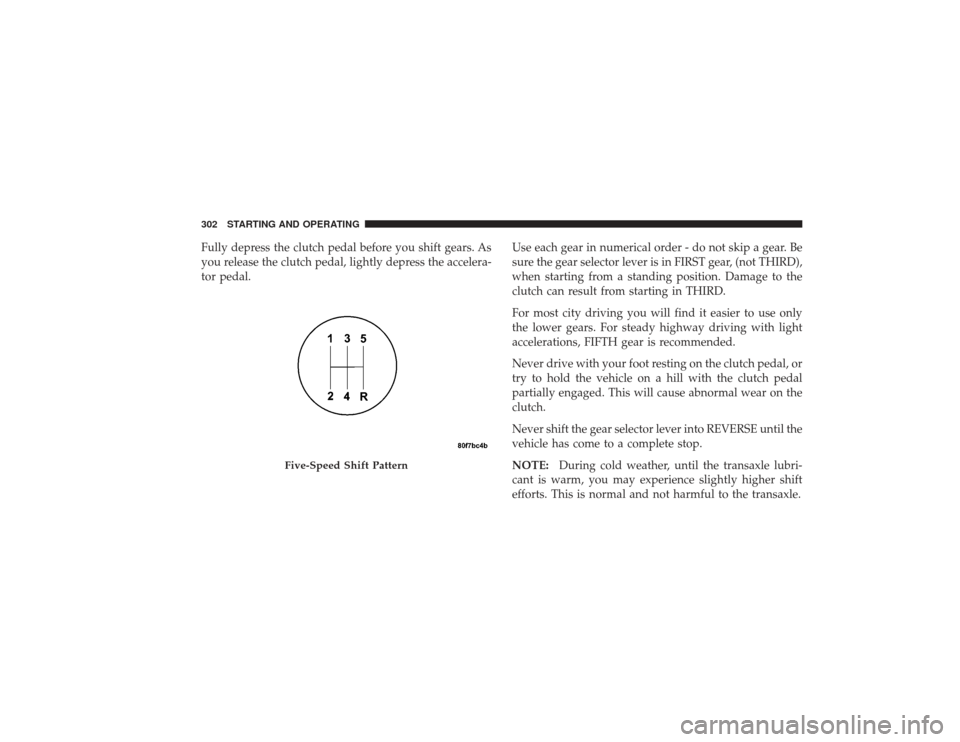
Fully depress the clutch pedal before you shift gears. As
you release the clutch pedal, lightly depress the accelera-
tor pedal.Use each gear in numerical order - do not skip a gear. Be
sure the gear selector lever is in FIRST gear, (not THIRD),
when starting from a standing position. Damage to the
clutch can result from starting in THIRD.
For most city driving you will find it easier to use only
the lower gears. For steady highway driving with light
accelerations, FIFTH gear is recommended.
Never drive with your foot resting on the clutch pedal, or
try to hold the vehicle on a hill with the clutch pedal
partially engaged. This will cause abnormal wear on the
clutch.
Never shift the gear selector lever into REVERSE until the
vehicle has come to a complete stop.
NOTE:
During cold weather, until the transaxle lubri-
cant is warm, you may experience slightly higher shift
efforts. This is normal and not harmful to the transaxle.
Five-Speed Shift Pattern
302 STARTING AND OPERATING
Page 305 of 491
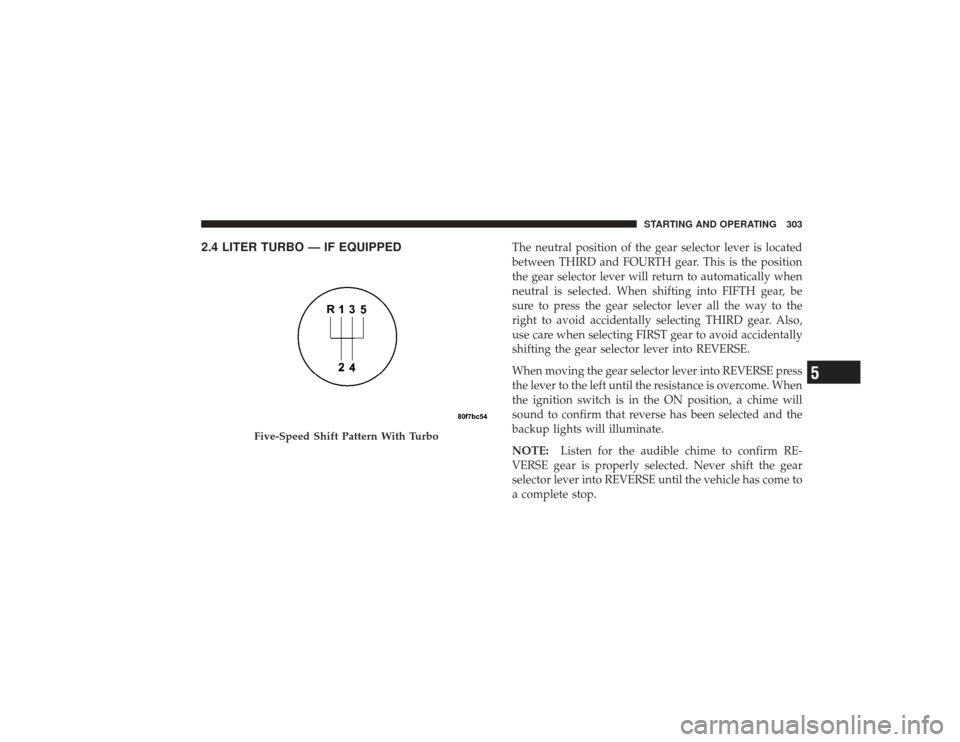
2.4 LITER TURBO — IF EQUIPPED
The neutral position of the gear selector lever is located
between THIRD and FOURTH gear. This is the position
the gear selector lever will return to automatically when
neutral is selected. When shifting into FIFTH gear, be
sure to press the gear selector lever all the way to the
right to avoid accidentally selecting THIRD gear. Also,
use care when selecting FIRST gear to avoid accidentally
shifting the gear selector lever into REVERSE.
When moving the gear selector lever into REVERSE press
the lever to the left until the resistance is overcome. When
the ignition switch is in the ON position, a chime will
sound to confirm that reverse has been selected and the
backup lights will illuminate.
NOTE:Listen for the audible chime to confirm RE-
VERSE gear is properly selected. Never shift the gear
selector lever into REVERSE until the vehicle has come to
a complete stop.
Five-Speed Shift Pattern With Turbo
STARTING AND OPERATING 303
5
Page 307 of 491
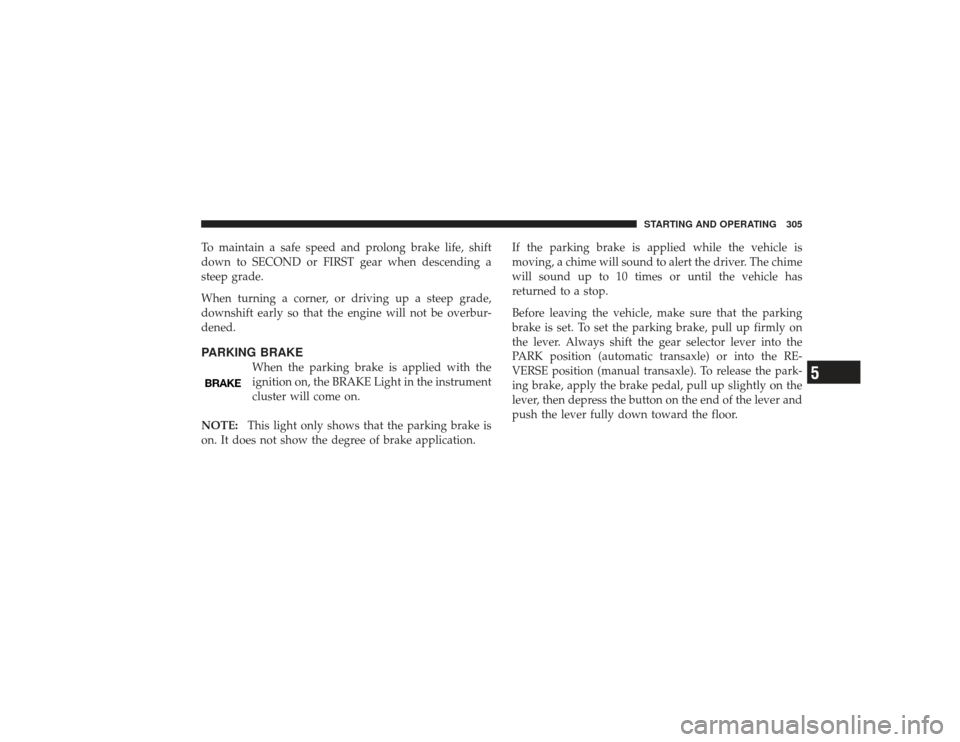
To maintain a safe speed and prolong brake life, shift
down to SECOND or FIRST gear when descending a
steep grade.
When turning a corner, or driving up a steep grade,
downshift early so that the engine will not be overbur-
dened.PARKING BRAKE
When the parking brake is applied with the
ignition on, the BRAKE Light in the instrument
cluster will come on.
NOTE: This light only shows that the parking brake is
on. It does not show the degree of brake application. If the parking brake is applied while the vehicle is
moving, a chime will sound to alert the driver. The chime
will sound up to 10 times or until the vehicle has
returned to a stop.
Before leaving the vehicle, make sure that the parking
brake is set. To set the parking brake, pull up firmly on
the lever. Always shift the gear selector lever into the
PARK position (automatic transaxle) or into the RE-
VERSE position (manual transaxle). To release the park-
ing brake, apply the brake pedal, pull up slightly on the
lever, then depress the button on the end of the lever and
push the lever fully down toward the floor.
STARTING AND OPERATING 305
5
Page 309 of 491
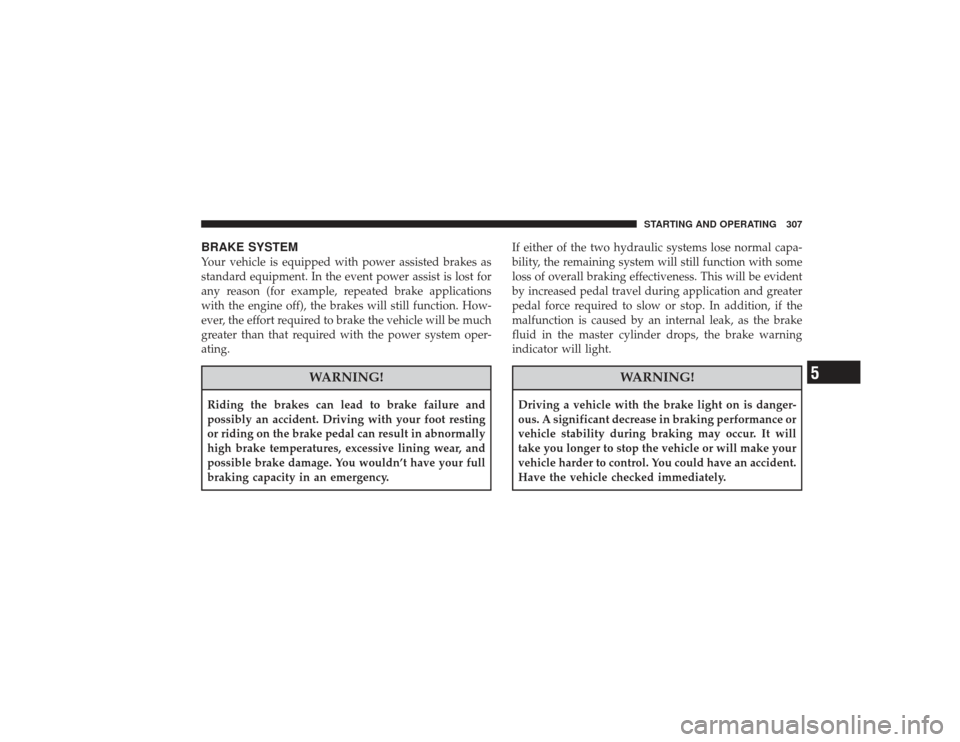
BRAKE SYSTEMYour vehicle is equipped with power assisted brakes as
standard equipment. In the event power assist is lost for
any reason (for example, repeated brake applications
with the engine off), the brakes will still function. How-
ever, the effort required to brake the vehicle will be much
greater than that required with the power system oper-
ating.
WARNING!
Riding the brakes can lead to brake failure and
possibly an accident. Driving with your foot resting
or riding on the brake pedal can result in abnormally
high brake temperatures, excessive lining wear, and
possible brake damage. You wouldn’t have your full
braking capacity in an emergency.If either of the two hydraulic systems lose normal capa-
bility, the remaining system will still function with some
loss of overall braking effectiveness. This will be evident
by increased pedal travel during application and greater
pedal force required to slow or stop. In addition, if the
malfunction is caused by an internal leak, as the brake
fluid in the master cylinder drops, the brake warning
indicator will light.
WARNING!
Driving a vehicle with the brake light on is danger-
ous. A significant decrease in braking performance or
vehicle stability during braking may occur. It will
take you longer to stop the vehicle or will make your
vehicle harder to control. You could have an accident.
Have the vehicle checked immediately.
STARTING AND OPERATING 307
5
Page 310 of 491
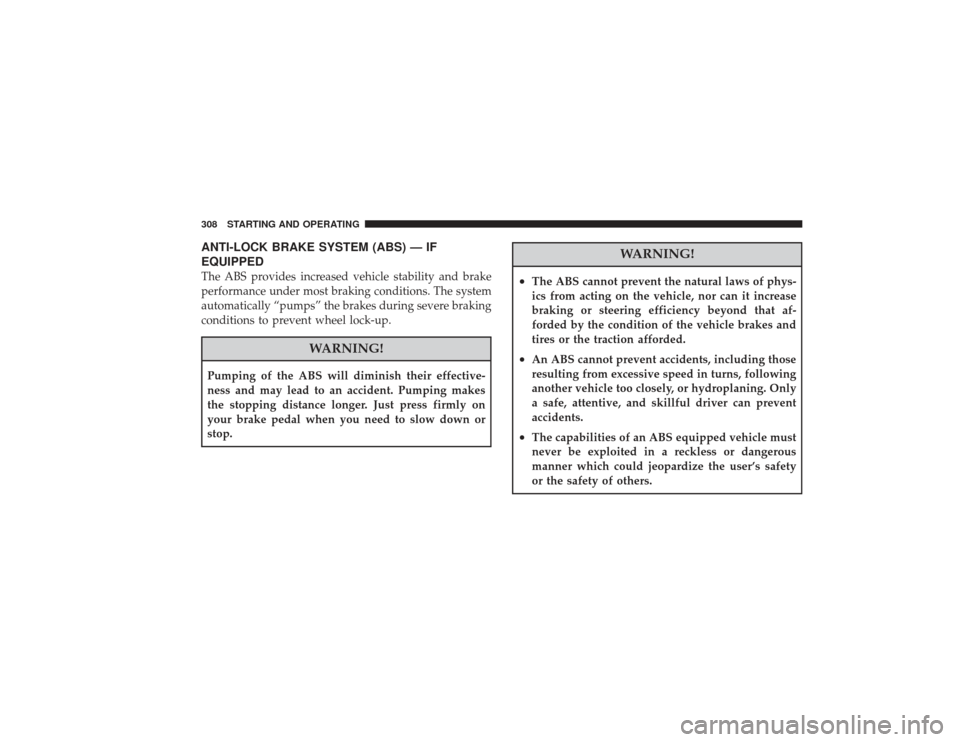
ANTI-LOCK BRAKE SYSTEM (ABS) — IF
EQUIPPEDThe ABS provides increased vehicle stability and brake
performance under most braking conditions. The system
automatically “pumps” the brakes during severe braking
conditions to prevent wheel lock-up.
WARNING!
Pumping of the ABS will diminish their effective-
ness and may lead to an accident. Pumping makes
the stopping distance longer. Just press firmly on
your brake pedal when you need to slow down or
stop.
WARNING!
•
The ABS cannot prevent the natural laws of phys-
ics from acting on the vehicle, nor can it increase
braking or steering efficiency beyond that af-
forded by the condition of the vehicle brakes and
tires or the traction afforded.
•
An ABS cannot prevent accidents, including those
resulting from excessive speed in turns, following
another vehicle too closely, or hydroplaning. Only
a safe, attentive, and skillful driver can prevent
accidents.
•
The capabilities of an ABS equipped vehicle must
never be exploited in a reckless or dangerous
manner which could jeopardize the user’s safety
or the safety of others.
308 STARTING AND OPERATING